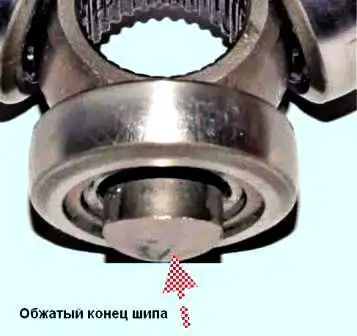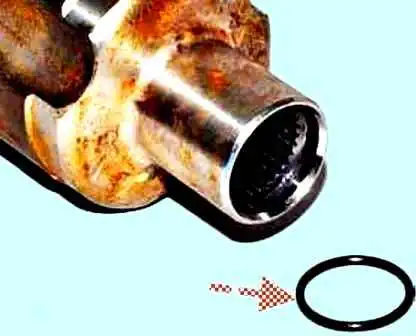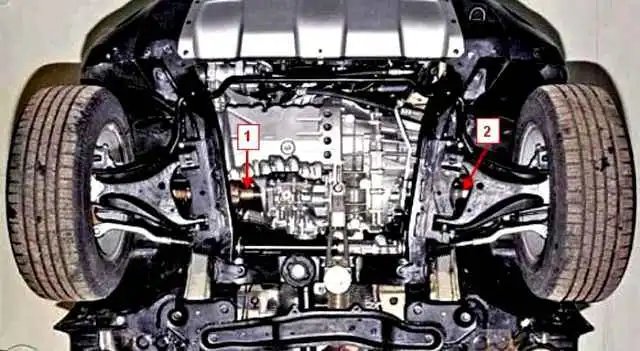Front wheel drives with equal angular velocity joints (CV joints) are used to transmit torque from the main gear installed in the gearbox to the front drive wheels at different wheel angles and suspension travels
The drives of the right and left front wheels are not interchangeable.
The wheel drive consists of inner and outer hinges of equal angular velocities connected by a shaft.
The drive shaft is made of forged steel bar.
Splines are made at the ends of the shaft, on which CV joints are installed.
External and internal drive joints have different designs.

The external drive joint provides the ability to transmit torque at various angles of rotation of the drive wheels.

The outer hinge consists of a body, a separator, a cage and eight balls, which are placed in the profiled grooves of the body and cage.
The separator constantly keeps the balls in the bisector plane between the body and the hinge cage and ensures uniform transmission of rotation from the cage to the body.
The hinge cage is mounted on the splines of the shaft and is fixed from longitudinal movement with a retaining ring.
The splined shank of the outer joint housing, at the end of which a thread is cut, is inserted into the front wheel hub and, when the nut is tightened, tightens the inner bearing rings.
The outer joints of the right and left front wheel drives are interchangeable.

Internal hinge of the drive provides the possibility of angular movements of the suspension and compensates for the mutual movements of the suspension and the power unit by changing the length of the drive shaft.
The inner joints of the right and left wheel drives on a 4x4 vehicle are not interchangeable due to the different design of their bodies.
At the splined end of the drive shaft, on the side of the inner hinge, there is a hub with three spikes - a three-stud, on each of the spikes (trunnion) of which there is a bearing, the outer ring of which has a spherical surface.
The inner ring of the bearing is mounted on a stud with clearance and has the possibility of significant axial movement along the stud.

As a result of the operation of the front suspension, the bearings will move in the three longitudinal grooves of the hinge body.
At the same time, the spikes of the three-stud can take different positions relative to the bearings.

Each end of the stud is crimped, as a result of which the bearing cannot be removed from the stud, so the assembly becomes non-separable.

A spring mounted inside the inner joint housing ensures that the joint housing is constantly pressed against the differential side gear.
The spline connection of the shank of the left wheel drive inner joint housing is fixedi in the side gear of the differential locking ring.

The splined hub of the right wheel drive hinge housing is put on a snug fit on the splines of the transfer case through shaft.
The tightness of the hinges is an indispensable condition for their reliable operation.
The tightness of the outer and inner hinges is ensured by dirt-proof covers fixed to the shaft and the housing with disposable metal clamps.
Special lubricant for wheel drive joints is placed in the outer and inner joints before assembly.
It does not require replenishment or replacement of lubricant or any other maintenance of the wheel drives during the operation of the vehicle.
It is only necessary to monitor the condition of the protective covers of the hinges in the fastening of their clamps.
Distinctive features of the front wheel drives of a 4x2 car

On a 4x2 vehicle, the right wheel drive inner joint housing rests on an intermediate support, which also holds the joint housing from axial displacement.
The support bearing of the intermediate support, pressed onto the shank of the hinge housing, is installed in the bracket of the engine block and is closed with a cover.
The cover is installed on the axis of the bracket and is attached to it with a bolt.
The splined end of the shank of the left wheel drive inner joint housing is inserted into the hole of the differential side gear.

On a 4x2 vehicle, the outer drive joints are interchangeable, while the inner ones are non-interchangeable.
Operations for repairing the front wheel drives of a 4x2 car are the same as the corresponding operations for the drives of a 4x4 car.
Possible Front Wheel Drive Malfunctions
Cause (Solution)
Vibration when driving:
- - Severe wear on the outer drive joint - Replace the worn joint
- - Deformation of the drive shaft - Replace the drive shaft
- - Wear on the rollers of the inner drive joint - Replace the inner joint
- - Loose hub nut - Tighten or replace the nut
Vehicle pulls to one side:
- - Wear or damage to the inner drive joint race - Replace the joint
- - Wear or damage to the outer drive joint - Replace the joint
- - Damage or deformation of the drive shaft - Replace the shaft
- - Loose hub nut - Tighten or replace the nut
Grease leaking from the joint:
- - Worn or torn outer or inner joint boot - Inspect the joint; if there is play, replace the damaged boot and grease
- - Insufficient clamp tightening - Replace and tighten the clamps securely
Noise, knocking from the front wheel when the vehicle is moving:
- - Damaged or deformed drive shaft - Replace the shaft
- - Runout of the front drive shaft - Replace the shaft
- - Damaged bearing of the intermediate support of the right front wheel drive of a front-wheel drive vehicle - Replace the bearing or drive assembly.
- - Worn inner drive joint rollers. - Replace the inner joint.
- - Loose hub nut. - Replace or replace the nut.
Knocking noise when turning the vehicle:
- - Severe wear on the outer drive joint. - Replace the joint.





